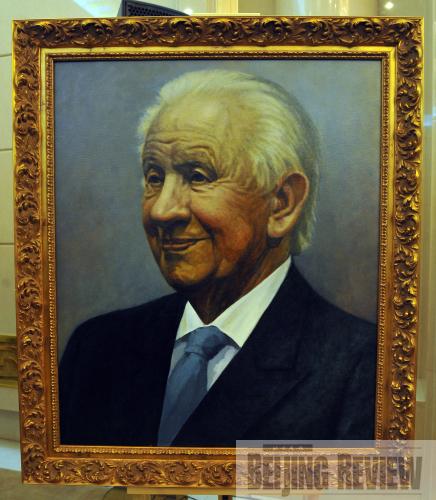|
 |
|
HELLO, OLD FRIEND: This portrait of Juan Antonio Samaranch, former Chairman of the International Olympic Committee, was painted by Dong Guoli DS CONSULTING |
Olympic medallists, having already reached the pinnacle of popular acclaim through their athletic feats as seen on TV screens worldwide, are about to experience celebrity of a more timeless variety—through the oil brushes of painters.
As part of a celebration for the first anniversary of the Beijing Olympics, the curtain will rise in October on an oil painting exhibition that is being organized cooperatively by the Western Returned Scholars Association, the sports channel of China Central Television (CCTV) and the China Overseas-Educated Scholars Development Foundation. Beginning at the National Stadium, the exhibition will tour through cities including Qingdao, Shanghai and Hong Kong. It will arrive in Guangzhou in time for that city's hosting of the 2010 Asian Games. The exhibition will display 200 oil paintings and present awards to the best ones.
Showing the spirit
Oil painting was introduced in China 300 years ago, but only really started to develop in the last 100 years. In 1905, Li Shutong went to Japan to learn oil painting, a move that is now regarded as a milestone in the development of oil painting in China. The form has become the most influential type of painting in the country besides Chinese traditional painting. The realistic style of oil painting, especially, has developed fastest and almost dominated China's oil painting market in the 20th century, according to Ma Lu, a professor at the China Central Academy of Fine Arts (CCAFA).
Ma took part in the exhibition, for which his "model" was ping-pong player Deng Yaping, the world's best for eight consecutive years, who won 18 world and four Olympic championships.
Some people still equate "realism" with "lifelikeness." Ma claimed that realism also involves creative and artistic techniques. "Realistic painting is the basic and most commonly used method of oil painting, but abstract art also evolved from realism," he said.
Ma defined the technique of figure painting as "showing the spirit of the figure by drawing his or her physical outlook," with that spirit being the most important part of the figure painting.
As an accomplished athlete and a successful career woman, Deng is famous for her spirit of fighting to be a winner. Born in 1973 to a ping-pong coach father, Deng showed great interest in the sport as a child and entered the local amateur sports school at the age of 5. But even after receiving many awards in ping-pong competitions including at the provincial level, Deng was still refused by the provincial ping-pong team, which said she was too short for the sport. "I am clear about the disadvantage of my shortness, but I don't think that should be an obstacle for me to be the best," Deng said in an interview with CCTV. She practiced very hard and improved. She was finally accepted by the national ping-pong team and proved to be a wonder in the history of the sport.
After retiring as an athlete, Deng enrolled in China's prestigious Tsinghua University. On the first day of class, she could not recite the 26 letters of the English alphabet and decided to throw herself into the most intense study. She eventually received a bachelor's degree from Tsinghua University, a master's degree from Nottingham University in the United Kingdom, and a doctorate from Cambridge University. During the 2008 Beijing Olympics, she was assigned as deputy director of the Olympic Village and continued her success off the court.
Ma attempts to show Deng's fighting spirit and triumph over adversity in his painting, in which Deng is bent over the ping-pong table holding a paddle, gazing at her rival.
Another artist, 37-year-old Yao Aibing, who graduated from the Beijing Film Academy majoring in fine arts, chose Guo Jingjing, the renowned Diving Queen, as his figure-painting model. Guo has won four Olympic championships and created a "Guo Jingjing era" in China's diving history. But instead of painting her on the diving board, Yao depicted Guo's quietness, with her palms together in front of her face and a blue sky and sea as the background.
"Even at the Olympic competitions, she looked very quiet and seemed not to care about the results. I think this is the essence of her spirit," Yao said. "I wanted to show this with the background."
Aside from sports stars, other figures that are quite familiar to Chinese people are also included in the exhibition. Juan Antonio Samaranch, former Chairman of the International Olympic Committee, is remembered by many Chinese people for announcing in 2001 that Beijing had won its bid for the 2008 Olympics. He is in a painting by Dong Guoli, a professional oil painter and member of the Liaoning Artists Association.
The exhibition also includes realistic scenery paintings. A giant painting called Impression of Beijing, which took Yao five years to complete, is composed of 2,008 small oil paintings with backgrounds of five different colors—green, red, yellow, blue and black—to show the scenery and common life in Beijing. The five colors represent spring, summer, autumn, winter and night of Beijing, respectively. They are also the colors of the five Olympic rings.
Oil painting development in China
"China's growing economic strength offers a very good opportunity for the development of oil painting. Now we have many styles of oil painting, and the realistic style ranks among the top few in the world," said Ai Xuan, a representative of realistic oil paintings and the Director of the Oil Painting Studio at the Beijing Fine Art Academy.
|
